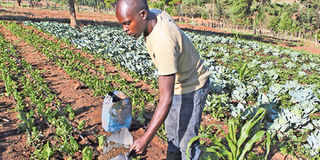Animal manure best for crop production

James Mauku uses bio-digested manure to cultivate vegetables in Elburgon. Using animal manure is a boost to the farmer as he does not have to buy commercial fertiliser. PHOTO | JOHN NJOROGE | NMG
What you need to know:
- The manure is collected from livestock and used in the field. This enables the farmer to practise a recycling system. Little goes to waste. The farmer only has to feed the animals, collect the droppings and convert it into manure.
- Poultry droppings, for example, have high calcium content. When used in the field, there would be no need of top dressing with calcium ammonium nitrate.
- Nitrogen is also a component of chrolophyll, an organelle essential for carbohydrate formation by photosynthesis.
- Potassium aids in photosynthesis and food formation, translocation of sugars and starches, increases protein content of plants, maintains cell turgor, reduces water loss and wilting and helps reduce the spread of diseases and nematode
The world is moving from chemically produced fruits, cereals, meat and vegetables to organically grown food.
Food produced organically is preferred by many because it has few pesticides, is fresh as it contains no preservatives and is friendly to the environment, among many other benefits.
To achieve this, the organic levels must be maintained right from the soil and at the root zones of the plants, where they draw their nutrients and water. For centuries, animal manure has been used as a source of plant nutrients.
Using animal manure is a boost to the farmer as he does not have to buy commercial fertiliser. That money can be used for other purposes.
The manure is collected from livestock and used in the field. This enables the farmer to practise a recycling system. Little goes to waste. The farmer only has to feed the animals, collect the droppings and convert it into manure.
When utilised properly, animal manure can help produce many crops. These include pasture and hay.
Nutrients in manure
Animal manure contains many types and levels of plant nutrient elements. These depend on various factors such as the type of the animal, the diet of the animal, where the animals are kept, the moisture content of as well as the storage method of the manure.
Poultry droppings, for example, have high calcium content. When used in the field, there would be no need of top dressing with calcium ammonium nitrate. Some of the nutrients present in animal manure include nitrogen, phosphorus and potassium.
These macro-nutrients are key to the crops in their early stages of development. Lack of these nutrients leads to diseases.
The nutrients in animal manure are released into the soil slowly. This means they can remain in the farm for long.
Soil fertility plays a big role in realising yields.
Some of the deficiencies associated with lack of nitrogen in the soil include stunted growth and
chlorosis or the yellowing of leaves. Nitrogen is an essential element of the amino acids.
These are the building blocks of plant proteins as they help in the growth and development of vital tissues and cells.
Nitrogen is a component of the nucleic acid that forms DNA, which helps hold the genetic code of the plant.
Nitrogen is also a component of chrolophyll, an organelle essential for carbohydrate formation by photosynthesis.
Thus, plants with sufficient nitrogen will experience high rates of photosynthesis and exhibit vigorous growth and development. Nitrogen in animal manure is in two forms: Organic and inorganic.
REDUCE DEFICIENCIES IN PLANTS
Organic nitrogen is usually released into the soil slowly during the decomposition of the manure.
The inorganic form of nitrogen is present in the form of ammonia, which is directly available to the crops.
The manure also contains phosphorus and potassium. These are in inorganic forms. Like nitrogen, these elements help reduce diseases.
Phosphorus also helps facilitate various processes like stimulating root development, increasing stalk and stem strength, improving flower formation and seed production, uniform and early crop maturity, increasing nitrogen-fixing capacity of legumes, improving crop quality, increased resistance to diseases and supporting development in the entire life cycle.
Potassium plays role in the growth and development of plants. It increases root growth and improves tolerance to drought. This is important for crops grown in arid and semi-arid regions. Potassium helps build cellulose and reduces lodging. It also activates at least 60 enzymes involved in plant growth.
Potassium aids in photosynthesis and food formation, translocation of sugars and starches, increases protein content of plants, maintains cell turgor, reduces water loss and wilting and helps reduce the spread of diseases and nematodes.
In addition to the above, animal manure contains calcium, magnesium and sulphur, micronutrients essential to the plants. These elements help reduce some deficiencies in the plants.
Magnesium and calcium help provide the liming effect to the soil, hence reducing the effects of acidity.
Soil structure
Apart from providing nutrients for growth and development of plants, animal manure has other roles to play in the soil.
It improves the soil structure. The excretes from the manure help in binding of soil particles into aggregates.
This, experts say, leads to improvement in soil fertility. Sandy soils which may have been eroded can thus be reclamated by applying manure.
The manure also boosts the levels of the organic matter in soil. This is the part of the manure that has not been digested by bacteria when producing nutrients.
Organic matter in the soil increases water infiltration, water holding capacity, enhances retention of nutrients, reduces wind and water erosion and promotes the growth of beneficial organisms. It is a challenge to quantify the amount of organic matter in the soil.
However, farmers should know that soil can be managed by constant addition of animal manure. Such soil has high fertility. Crops tend to do very well in such soils.
The writer is an Msc Soil Science student, Department of Crops, Horticulture and Soils, Egerton University.




